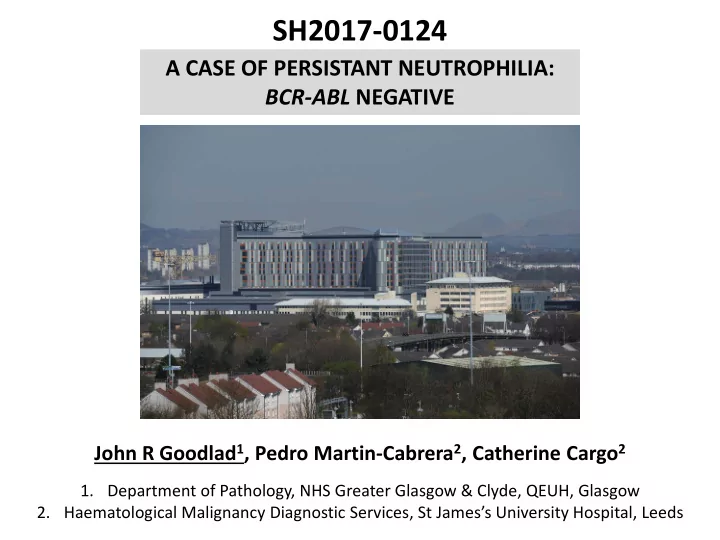

SH2017-0124 A CASE OF PERSISTANT NEUTROPHILIA: BCR-ABL NEGATIVE John R Goodlad 1 , Pedro Martin-Cabrera 2 , Catherine Cargo 2 1. Department of Pathology, NHS Greater Glasgow & Clyde, QEUH, Glasgow 2. Haematological Malignancy Diagnostic Services, St James’s University Hospital, Leeds
CLINICAL HISTORY An 80 year old male presented with anaemia and persistently raised white • cell count (70.2 x 10 9 /l) • Blood film • Differential: Neutrophil morphology: • Neutrophils 81% (57 x 10 9 /l) Some very well • • Lymphocytes 3.6% granulated/toxic granulation • Monocytes 2% Some dysplastic • • Eosinophils 2% Hypogranular cytoplasm • • Promyelocytes 1.6% Hypolobated nuclei • • Myelocytes 4.3% Pseudo-Pelger Huet forms 11.4% • • Metamyelocytes 5% • Blasts 0.5% • No basophils • • Molecular testing: • No evidence of BCR-ABL fusion • CALR normal • JAK2 V617F normal
BONE MARROW ASPIRATE AND TREPHINE Flow Cytometry: Neoplastic myeloid progenitors = 1.0% of total cells, composite phenotype: CD45+CD34+CD117+ CD15-CD13+HLADR+ CD33+/-CD7+/- CD64-CD56- • Monocytic cells (CD64+CD14(78%)+CD56-) = 3.44% of total cells. • Trephine: Hypercellular marrow with expanded myeloid series and increased and atypical megakaryocytes
ASPIRATE Dysplastic changes in myeloid series (no ring sideroblasts)
ADDITIONAL RESULTS Cytogenetic/FISH: Normal male karyotype • Targeted High throughput sequencing: • CSF3R mutated (p.Thr618Ile, c1853C>T) • SETBP1 mutated (p.Asp868Asn, c2602G>A) Sanger sequencing: SRSF2 mutated (p.P95L, c.284C>T) • MPL exon 10 normal •
PROPOSED DIAGNOSIS ATYPICAL CHRONIC MYELOID LEUKAEMIA No follow-up available Diagnosis of atypical CML generally associated with poor prognosis Overall median survival approx. 25 months • 40% transform to acute leukaemia • (Breccia M et al, Haematologica 2006)
Diagnostic criteria for atypical CML (2016) Peripheral blood leukocytosis ≥ 13 x 10 9 ✔ Due to increased neutrophils and precursors ✔ • Dysgranulopoiesis, may include abnormal chromatin clumping • ✔ Immature granuloyctes (promyelocytes, myelocytes, metamyelocytes) • account for ≥ 10% of white cells ✔ Myeloblasts <20% white cells • ✔ No or minimal absolute basophilia; <2% leukocytes ✔ No or minimal monocytosis; monocytes <10% of leukocytes Hypercellular bone marrow ✔ Granulocytic proliferation and dysplasia +/- dysplasia in erythroid and • megakaryocyte lineages ✔ Myeloblasts <20% nucleated cells • No evidence of PDGFRA, PDGFRB or FGFR1 rearrangement, or PCM1-JAK2 ✔ Not meeting criteria for BCR-ABL1+ CML, PMF, or ET
CSF3R MUTATIONS (Dwivedi P and Greis KD, Exp Hematol 2017;46:9-20) CSF3R is the receptor for Granulocyte Colony Stimulating Factor • Transmembrane protein of 813 amino acids • Binding by ligand induces conformational change and activation of downstream pathways Neutropenia (severe congenital neutropenia & chronic idiopathic neutropenia ) Myeloid neoplasms e.g. T618I (constitutive activation of JAK/STAT) SCN AML/MDS (SRC Kinase activity ) JAK/STAT MAPK/ERK GRANULOCYTE PROLIFERATION PI3K/AXT GRANULOCYTE DIFFERENTIATION
CSF3R MUTATIONS IN ATYPICAL CML 2013: 1 st descriptions of CSF3R mutations in myeloid neoplasms 8/17 (47%) cases of aCML (n=4) • or suspected aCML (n=3) • 8/9 (89%) cases of CNL N Eng J Med 2013.368.1781. Later studies suggest real incidence of CSF3R mutations in aCML likely to be much lower Author Number of cases harbouring mutated CSF3R Pardanani A et al, Leukemia 2013 0/9 (0%) Wang SA et al, Blood 2014 0/27 (0%) Meggendorfer M et al, Haematologica 2014 2/58 (3%) Patnaik MM et al, Am J Hematol 2017 2/25 (8%) Gambacorti-Passerini CD et al, Blood 2015 0/15 (0%) TOTAL 4/134 (3.0%) (7.9% incl Maxon cases)
CSF3R MUTATIONS IN CNL AND OTHER MYELOID NEOLASMS CSF3R mutations in myeloid neoplasms (combined results) Number % Refs 1. Pardanani A, Leukemia 2013 2. Maxson JE, NEJM 2013 CNL 32/49 65% 1-3,7 3. Meggendorfer M, Haematologica 2014 aCML 12/151 7.9% 1-3 4. Tefferi A, Haematologica 2013 5. Sano H, Br J Haematol 2015 CMML/JMML 8/470 1.7% 1,3,5,6 6. Hwang SY, Ann Hematol 2015 MDS 0/88 0% 5,6 7. Cui Y, J Hematol Oncol 8. Kosmider O, Leukemia 2013 PMF 0/76 0% 1 9. Wang SA, Blood 2014 ET 0/21 0% 5 10. Patnaik MM, Hematology 2017 11. Gambacorti-Passerini CB, Blood 2015 De novo AML 20/2364 0.8% 2,4-6 CSF3R mutations are relatively specific for CNL amongst myeloid neoplasms
SETBP1 MUTATIONS IN ATYPICAL CHRONIC MYELOID LEUKAEMIA Initial studies indicated relatively high frequency in aCML, e.g. Piazza R et al, Nat Genet 2013: 17/70 ( 24.3% ) Gambacorti-Passerini CB et al, Blood 2015: 4/15 (26.7%) Meggendorfer M et al, Leukemia 2013: 19/60 ( 31.7% ) May also present in CNL, e.g. Piazza R et al, Nat Genet 2013: 1/4 ( 25% ) Pardanani A et al, Leukemia 2013: 4/12 ( 33% ) Low incidence/not present in other myeloid neoplasms, e.g./
SETBP1 MUTATIONS IN MYELOID NEOPLASIA Piazza R et al, Nat Genet 2013.45.18-24
CSF3R AND SETBP1 MUTATIONS MAY CO-EXIST IN aCML & CNL Cases of CNL with CSF3R mutation often also harbour mutation of SETBP1 Pardanani A et al 2013: 40% (4/10 cases) • Cui Y et al 2014: 60% (6/8 cases) • Cases of aCML with SETBP1 mutation may also have CSF3R mutation, e.g. Meggendorfer M et al, 2014 • Hypothesized that presence of both mutations infers bad prognosis/resistance to JAK inhibitor (Ruxolitonib) in CNL and aCML: Lasho TL et al, Leukemia 2014 Ammatuna E et al, Ann Hematol 2015
SUMMARY Initial study of this case raised a differential diagnosis (aCML vs CNL) Targeted molecular testing, performed to help refine the diagnosis, revealed mutations of SETBP1 and CSF3R A diagnosis of aCML made in light of: Appropriate morphological findings • Dysplastic features present • Help exclude CNL Left shift in peripheral blood • Compatible/suggestive mutational profile, i.e. • SETBP1 mutations associated with aCML • CSF3R mutations more specific for CNL • But both mutations may co-exist in aCML • Highlights the importance of interpreting molecular abnormalities in the context of other findings
ACKNOWLEDGEMENTS HMDS, St James’s University Hospital, Leeds Jan Taylor Paul Evans Sharon Barrans Matthew Cullen
FINAL PANEL DIAGNOSIS Atypical chronic myeloid leukemia, BCR-ABL1 -negative
Recommend
More recommend